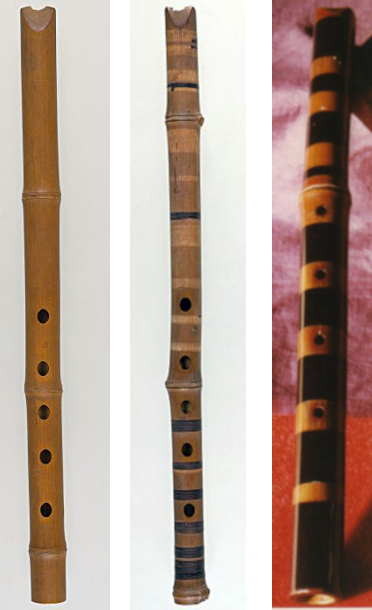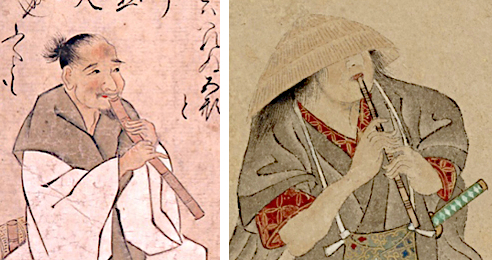Shakuhachi History

Left and Middle: Oldest shakuhachi in Japan, 8th c. 'above root' bamboo, Shoso-in, Nara
Right: Ikkyu Sojun's 'above root' shakuhachi, mid 1400's
Mainland to Japan
The first shakuhachi were imported to Japan from China or the Korean peninsula during the Nara period (710-794 AC). These shakuhachi were a part of court music or Gagaku 雅楽, as it's translated into Japanese. They were made from bamboo poles, jade, various stones, and ivory. Shakuhachi were also shorter around 1.08 in length or ichi-shaku-hachi-bu (32.7cm/12.8in); 22cm shorter than the later and current standard of 1.8 or ichi-shaku-hachi-sun (54.5cm/21.5in). The shakuhachi would also see other variations and evolutions before reaching the root end form we're familiar with today. For example, the root end did not come into use until nearly one thousand years after the arrival of the first shakuhachi in Japan (8th c. to late 17th c.).
Komoso to Komuso - Commoner to Samurai

Left: 'Commoner' Komoso shakuhachi beggar monk
Right: Samurai turned Komoso shakuhachi monk with Katana sword, 16th and 17th c.
The shakuhachi was replaced in the Gagaku ensemble and later resurfaced in the hands of commoners, particularly the Komoso or 'straw mat monks' 薦僧/菰僧 who would play shakuhachi form alms. From the mid to late 16th century, many Samurai found themselves ronin or 'masterless', i.e., without a livelihood. As a result, an increasing number of them were joining the ranks of the Komoso shakuhachi beggar monks.
The Samurai went on to create their own exclusive order and began calling themselves the Komuso or 'illusory nothingness monks' (虚無僧). It's generally believed that the Samurai Komuso eventually began using the root end of the bamboo for shakuhachi and they extended the standard length by roughly 22cm; from 1.08 to 1.8 shaku.
An unofficial Zen Buddhist sect was formed by and for the Komuso called the Fuke Shu. The Tokugawa Shogun government allowed the Fuke Shu to establish themselves, though no formal recognition as a legitimate sect of Buddhism was ever granted, nor recognized by the Zen Buddhist Sects. The Komuso developed a number of refined styles of Honkyoku which are considered to be spiritual or meditative pieces of shakuhachi music (see Komuso shakuhachi monks for more).
Shakuhachi as a weapon
We'll never know to what extent or how often the shakuhachi was used as a weapon during the Edo period and earlier. However, what we should call into question are those who still perpetuate fantasies of bloodshed, especially without condemning violence, all in order to tantalize at the expense of the greater artistic and spiritual legacy of the Komuso monks and their direct descendants.
The Meiji Restoration
The Meiji Restoration (1868-1912) was revolution that restored imperial rule to Japan under Emperor Meiji. One of the goals of the Meiji Restoration was to purge Japan of the foreign influence of Buddhism in favor of a nationalized version of Shinto. One of the early slogans of the Meiji Restoration was, 'Sweep aside the Buddha: Smash Buddhism'.
As a result, during the Meiji Restoration the Fuke shu of the Komuso was dissolved, due to both its Buddhist associations and Samurai origins. This included the playing of Honkyoku which was also officially banned. Despite this, secular folk and ensemble shakuhachi playing with Koto and Shamisen continued to grow in popularity.
At one point, the Meiji Empire tried to ban the shakuhachi altogether, however, Kinko Ryu Grandmasters Araki Kodo II and Yoshida Ittcho succeeded in convincing the Empire to continue to allow the shakuhachi in these secular settings. Eventually, nonsecular Buddhist activities were allowed to resume, including those of the Komuso, though the Fuke shu was never restored.
Shakuhachi in the 20th c. to now
Through the 20th century, the shakuhachi, like the rest of Japan, experienced relatively sweeping changes, both with its construction and the music which was played on it. For instance, an increasing number of shakuhachi practitioners were drawn to the Tozan Ryu, with its focus on playing contemporary music genres on shakuhachi and learning to read Staff musical notation, in addition to Katakana based shakuhachi notation. To this day, in Japan the Tozan Ryu and non-traditional shakuhachi music dominate, though all traditional arts are on an ever steeper decline in the country.
It was also in the 20th century that we saw a growing export of the shakuhachi to the rest of the world, both from Japanese and non-Japanese people. Most non-Japanese shakuhachi enthusiasts were drawn to the traditional forms of shakuhachi music, but especially the Zen Honkyoku. Indeed, some estimate that within the early 21st century there will easily be more shakuhachi practitioners outside of Japan than within it, especially with the growing popularity of shakuhachi in other East Asian countries like China.
As a direct result of Japan's extensive 'export culture' via manga, anime, and video games, in the 21st century we're seeing a relatively small, yet increased interest in the shakuhachi outside of Japan. In 2020, the American developed game Ghost of Tsushima was the first to feature the shakuhachi as a playable accessory that gamers could use. Though mostly just for 'show', this addition of the shakuhachi in Ghost of Tsushima introduced the shakuhachi to thousands of people around the world.
Perhaps this will also 'come back home' and result in a resurgence of interest in the shakuhachi with Japanese people living in Japan. For now, there continues to be an ever diminishing interest in the shakuhachi within Japan, along with all other traditional Japanese arts. For an idea of the situation all Japanese traditional art forms face, to varying degrees, see the video below by youtuber Shogo san, who also plays shakuhachi.